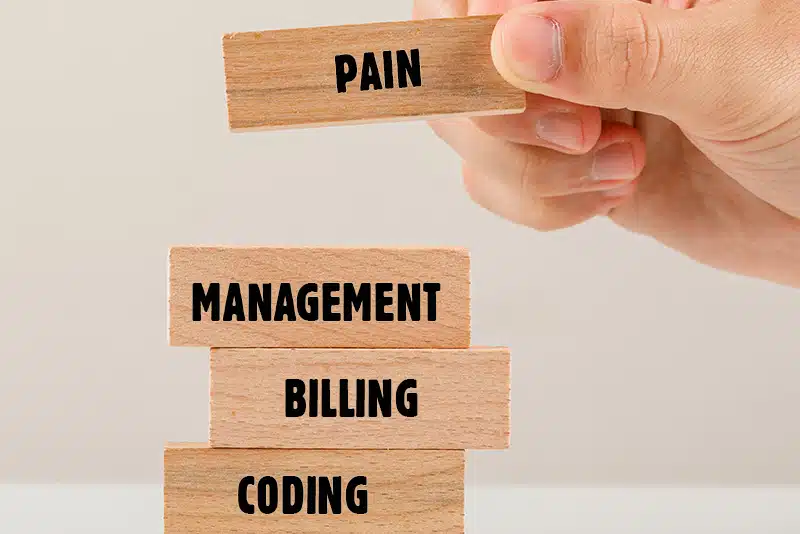Effective billing and coding practices play a crucial role in the financial stability and operational efficiency of pain management practices. Pain management involves a wide range of procedures, interventions, and medications, each requiring specific coding. The complexity of coding guidelines, such as CPT, ICD-10, and HCPCS, poses a challenge in accurately capturing and documenting the services provided. Accurate pain management medical billing and coding is the foundation for proper reimbursement, compliance with regulations, and effective communication with payers. Pain management coding guidelines provide the framework for accurately documenting and coding pain management services.
Every year, the Centers for Medicare & Medicaid Services (CMS) revise the guidelines for chronic care management. Providers must stay updated on the latest coding changes and billing guidelines to ensure proper reimbursement. Although the fee schedules for chronic care management in 2022 remain the same for 2023, CMS implemented modifications to chronic pain management (CPM) to prioritize billing accuracy. Let’s explore the key components of pain management coding guidelines in 2023.

Looking to streamline your pain management medical billing and boost revenue?
Bundled Payment Codes for Chronic Pain Management in 2023
-
- Two new bundled payment codes
Effective January 1, 2023, the Centers for Medicare and Medicaid Services (CMS) approved the coverage and payment of new bundled payment codes for chronic pain management (CPM). This decision by CMS highlights their commitment to enhancing the care provided to individuals with chronic pain and ensuring that the time and resources dedicated to delivering comprehensive CPM services are accurately represented.
The new CPM codes are: G3002 and G3003. The CMS codes for 2023 outline a comprehensive set of services offered by pain-treating physicians to patients on a monthly basis. Instead of invoicing individual services separately, specialists now have the option to use a bundled code, simplifying the process of collecting payment for the care provided. The code descriptors provides a detailed breakdown of the services included and reviewing it can provide a complete understanding of the contents of the CPM bundle, it is advisable to review.
-
-
- G3002: Chronic pain management and treatment, monthly bundle including, diagnosis; assessment and monitoring; administration of a validated pain rating scale or tool; the development, implementation, revision, and/or maintenance of a person-centered care plan that includes strengths, goals, clinical needs, and desired outcomes; overall treatment management; facilitation and coordination of any necessary behavioral health treatment; medication management; pain and health literacy counseling; any necessary chronic pain related crisis care; and ongoing communication and care coordination between relevant practitioners furnishing care, e.g. physical therapy and occupational therapy, complementary and integrative approaches, and community-based care, as appropriate. Required initial face-to-face visit at least 30 minutes provided by a physician or other qualified health professional; first 30 minutes personally provided by physician or other qualified health care professional, per calendar month. (When using G3002, 30 minutes must be met or exceeded.)
- G3003:Each additional 15 minutes of chronic pain management and treatment by a physician or other qualified health care professional, per calendar month. (List separately in addition to code for G3002. When using G3003, 15 minutes must be met or exceeded.)
-
Consistency between the billed services and the specifications in the code descriptors is crucial to ensure accurate billing.
-
- CMS: Chronic Pain is Pain that lasts Longer than Three Months
CMS now defines chronic pain as “persistent or recurrent pain lasting longer than 3 months” (a time period that chronic pain specialists have long utilized). This definition might prompt some providers to think the CPM codes are restricted to established patients, but that is not the case, notes an article in Practical Pain Management. Specifically, the Fee Schedule states: “The beneficiary, at the first visit, need not have an established history or diagnosis of chronic pain, or be diagnosed with a condition that causes or involves chronic pain; rather, it is the clinician’s responsibility to establish, confirm, or reject a chronic pain and/or pain-related diagnosis when the beneficiary first presents for care and the clinician is using HCPCS code G3002”.
-
- Guidelines and Requirements for Billing the new CPM Codes
Here are some additional guidelines for billing G2002 and G3003:
-
- G2002 covers the evaluation, diagnosis, and ongoing monitoring of a patient’s pain, involving collaboration with other healthcare professionals to optimize treatment and achieve improved outcomes. This code specifically covers the initial 30 minutes of chronic pain management care.
- The add-on code, G3003 can be utilized if providers exceed the 30-minute time threshold for CPM. It’s important to note that G3003 is specifically designated as an add-on code, which means it can only be reported if the provider spends more than the allocated 30 minutes on CPM. Clinicians have the flexibility to report G3003 multiple times within a given month, allowing them to account for every additional 15 minutes of chronic pain management care beyond the initial 30 minutes specified by G3002.
- The initial visit must occur with a physician or qualified healthcare professional (QHP) in a clinical setting, where both the provider and the patient are physically present, lasting a minimum of 30 minutes. Following the initial visit, certain in-person components specified in the codes may be delivered through telehealth, as deemed suitable and clinically appropriate. Additionally, certain aspects of the proposed bundle, such as care planning or coordination with other healthcare professionals, may not necessarily require face-to-face interaction.
- Auxiliary personnel are not permitted to provide services as incidental to the professional services of a physician or other qualified healthcare professional (QHP). This means that the services must be directly performed by the physician or QHP themselves and cannot be delegated to auxiliary staff.
- During the initial visit, it is necessary to obtain verbal consent from the beneficiary, which should be documented in their medical record. Beneficiaries should receive comprehensive education regarding the nature of the chronic pain management (CPM) services, including the frequency at which they can typically expect to receive these services. It is important to inform beneficiaries about any applicable cost sharing that may be involved in their specific situation.
- CPM services can be billed on the same day as evaluation and management (E/M) services or within the same month as remote physiologic monitoring (RPM) services, remote therapeutic monitoring (RTM) services, and care management services like chronic care management (CCM), transitional care management (TCM), or behavioral health integration (BHI) services, as long as all the necessary requirements for reporting each service are fulfilled. It’s important to note that the time dedicated to providing CPM services cannot be counted towards any other service that is furnished and billed separately.
- There is no limit to the number of physicians or qualified healthcare professionals who can bill G3002 for a beneficiary in a given month, as long as it is medically necessary. After G3002 has been billed, G3003 can be billed multiple times for the same beneficiary and month, as medically necessary. However, it is important to note that CMS will be monitoring the utilization of these codes.
- CPM services can be provided only in office or other outpatient or domiciliary settings.
-
- Reporting Evaluation and Management (E/M) Visits
Providers can report both evaluation and management (E/M) visits, specifically, codes 99202-99215 in an office setting, in conjunction with the CPM codes. However, it is crucial that the documentation clearly shows a distinct E/M visit that is separate from the time and documentation related to the CPM service. Essentially, if the medical record is reviewed, it should be possible to extract the E/M documentation from the CPM note, and both the E/M visit and the CPM service should individually demonstrate the time spent and the elements addressed without overlapping or duplication.
The inclusion of CPM coverage reflects CMS’s recognition of the growing significance of care management for individuals with chronic diseases, such as chronic pain, in effectively managing their conditions and minimizing the reliance on expensive urgent and emergency care services.

Take the first step towards efficient revenue cycle management and improved cash flow.
Maximize Revenue with Outsourced Medical Billing Services
Pain management is specialized area of healthcare presents unique challenges that can hamper accurate and timely reimbursement. Pain management includes a wide range of procedures, interventions, and medications, each requiring specific coding. Complex coding, lack of specificity, and evolving payer policies contribute to claim rejections. Providers must stay updated on the latest coding changes and guidelines to ensure proper reimbursement.
Providers can overcome these challenges by outsourcing pain management billing. Medical billing companies employ professionals with expertise in medical coding, billing regulations, and payer requirements. They stay up-to-date with changes in coding guidelines, compliance regulations, and industry trends. Partnering with a pain management medical billing company offers the advantage of specialized expertise for navigating complex reimbursement processes, ensuring accurate coding, and maximizing revenue collection.


